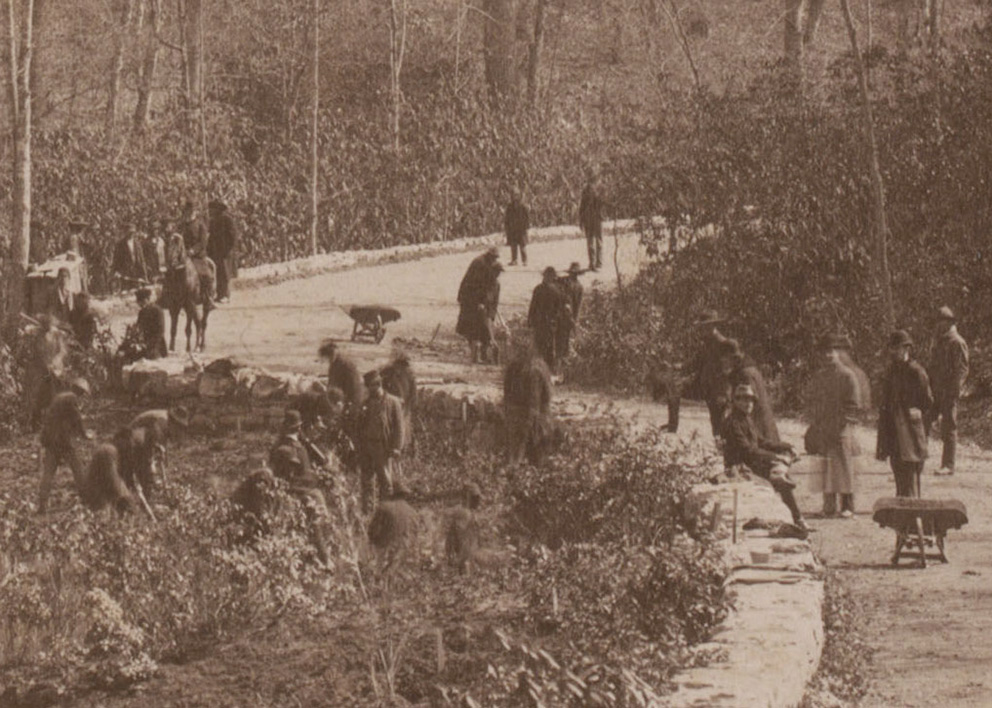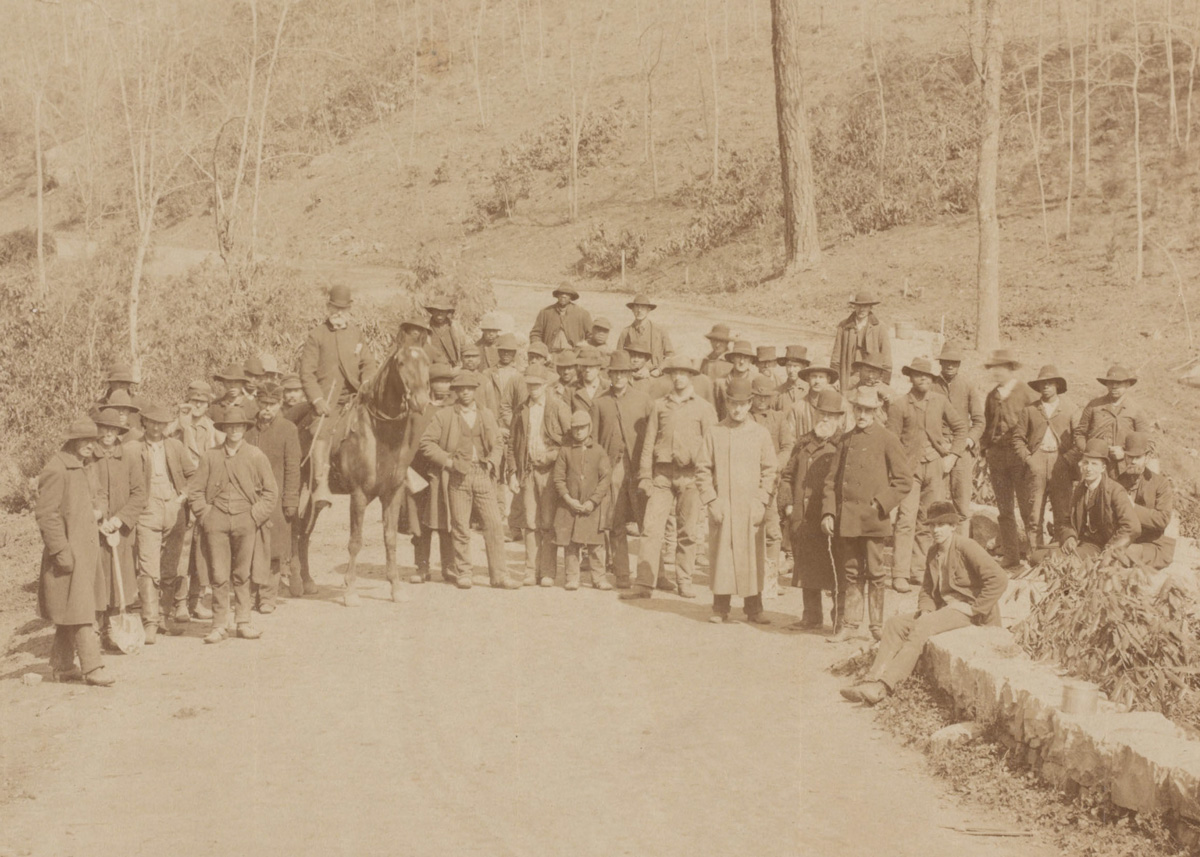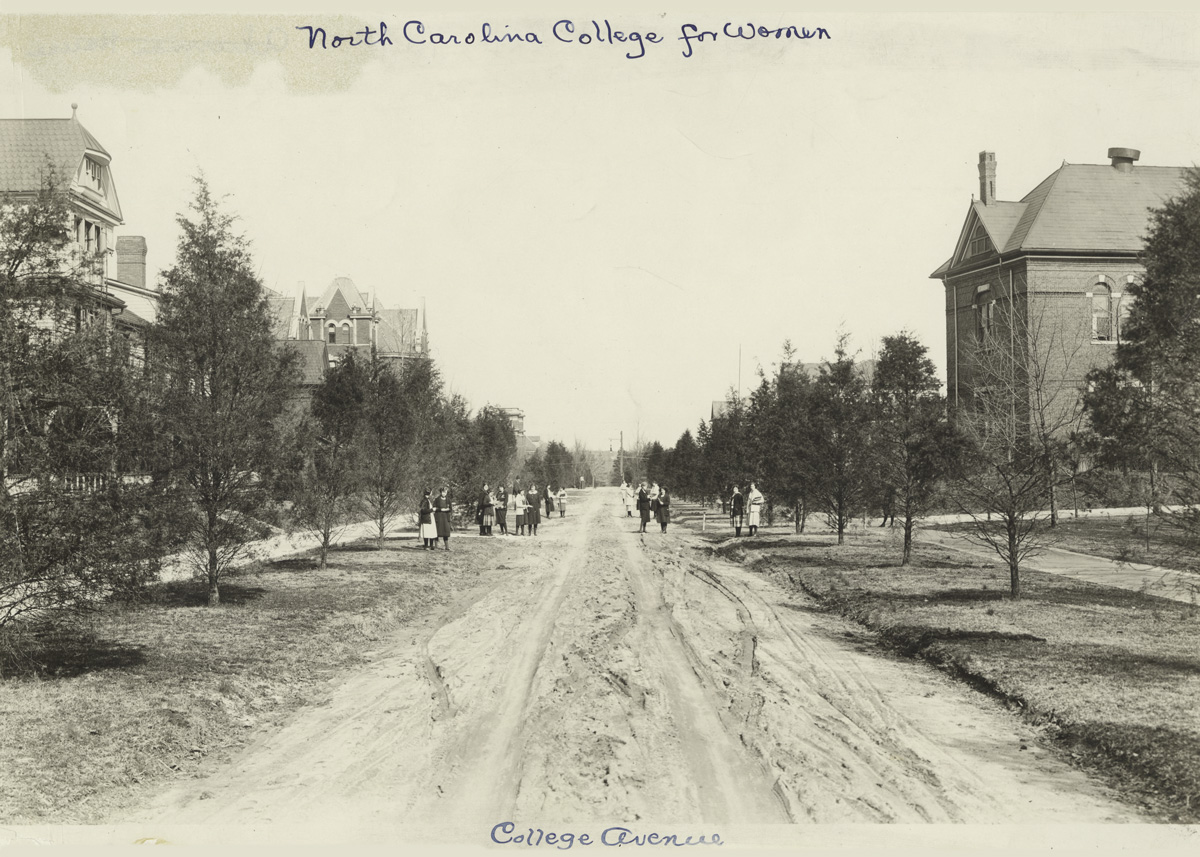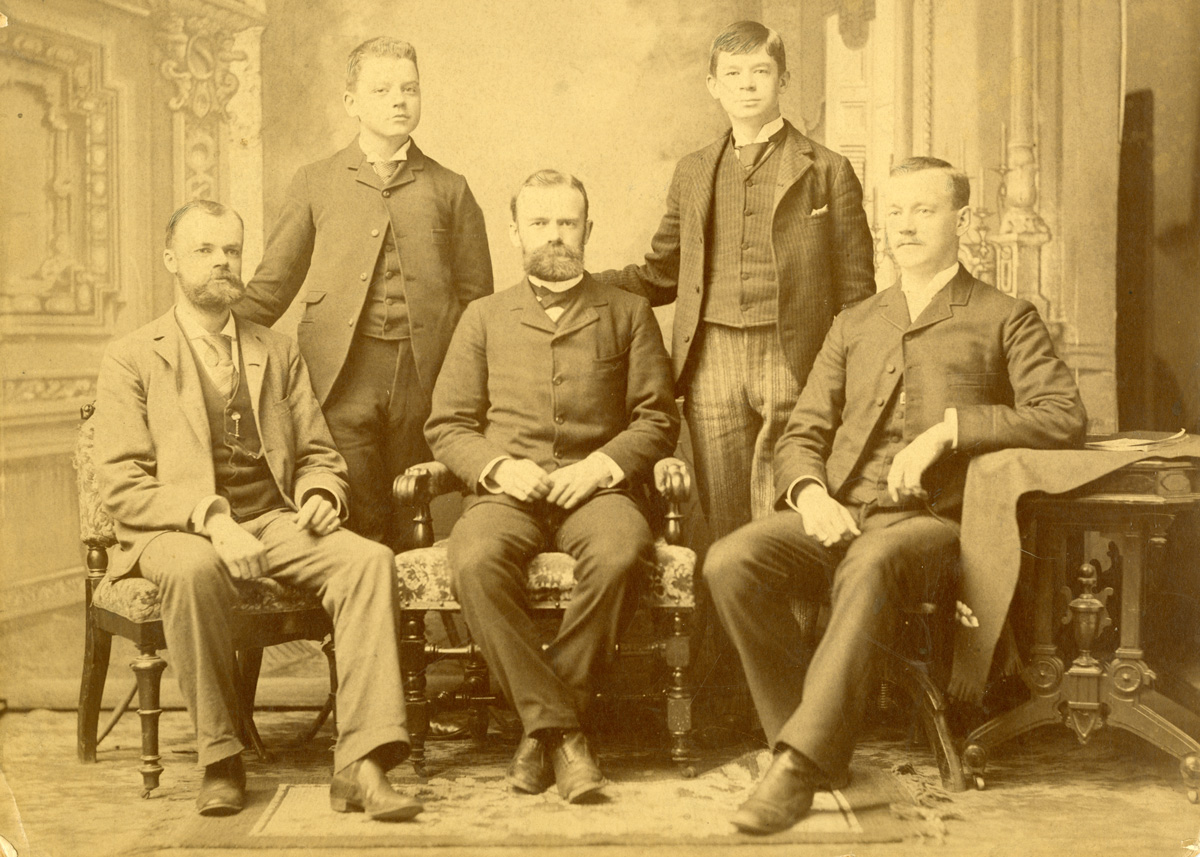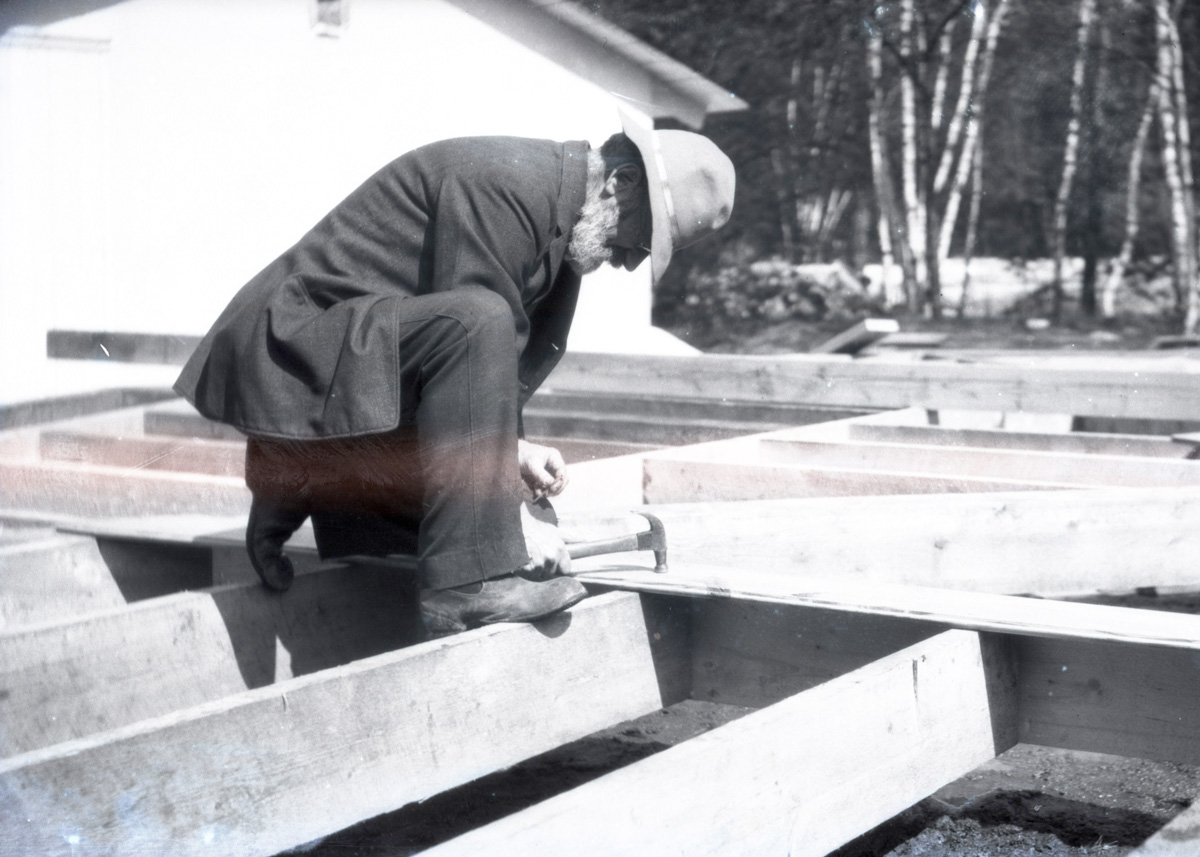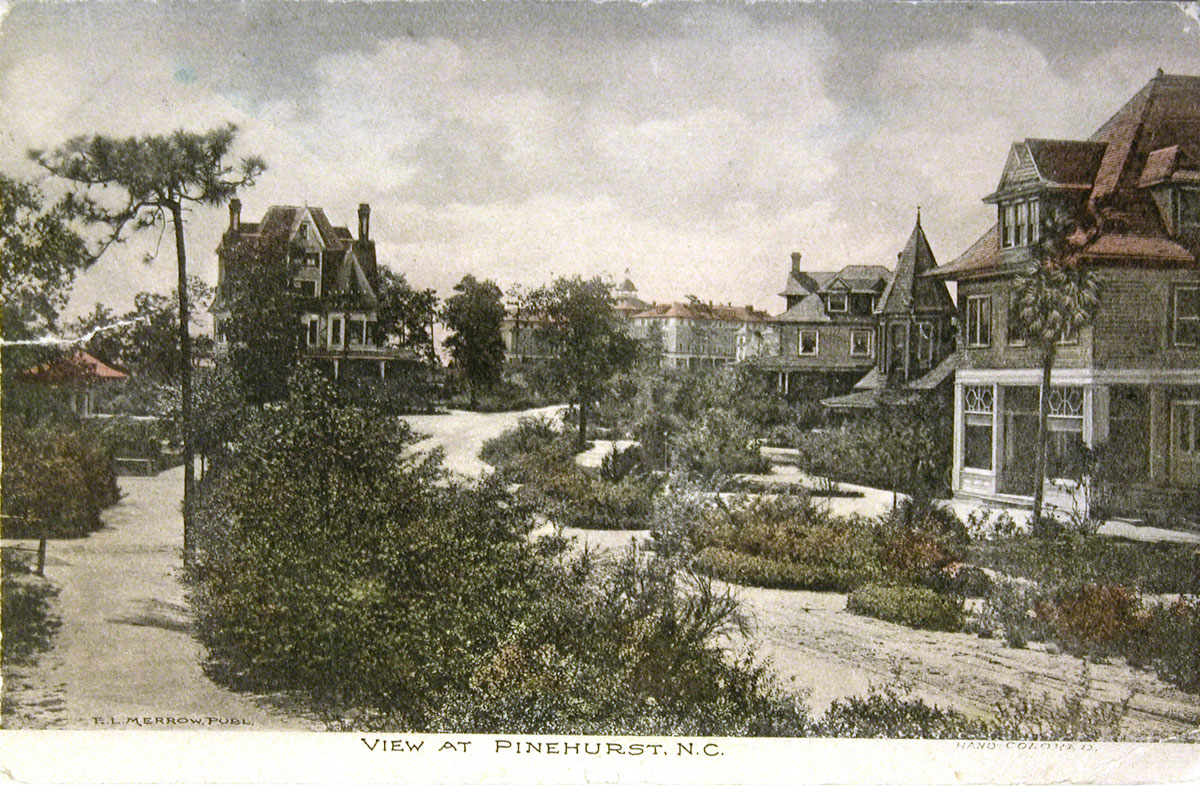
How did UNC Greensboro come to be so beautiful?
The vision started with one long, picturesque avenue lined with trees and plantings. And behind this vision were people who wanted something better for the current students and future generations. With pluck and promise, they gave us the UNCG campus core we know today – the most naturally beautiful in the state. Its origin is a story little-told, of an incredible gift and one of the most respected landscape designers in the nation. And what a tale.
The land itself was a gift. Philanthropists Richard Pullen and Robert T. Gray donated the original acreage, much of it farmland. The earliest students arrived to find corn stalks gracing their view. Lula McIver summed it up: “two buildings, ten acres of mud, and one tree.”
Soon came what President McIver called the growing college’s most important gift ever.
Kittie Dorcas Dees was the donor. Know the name? These days, few do. Treasurer and longtime faculty member E.J. Forney envisioned this young alumna would have a campus lane or road named after her someday, so her story would serve as an inspiration.
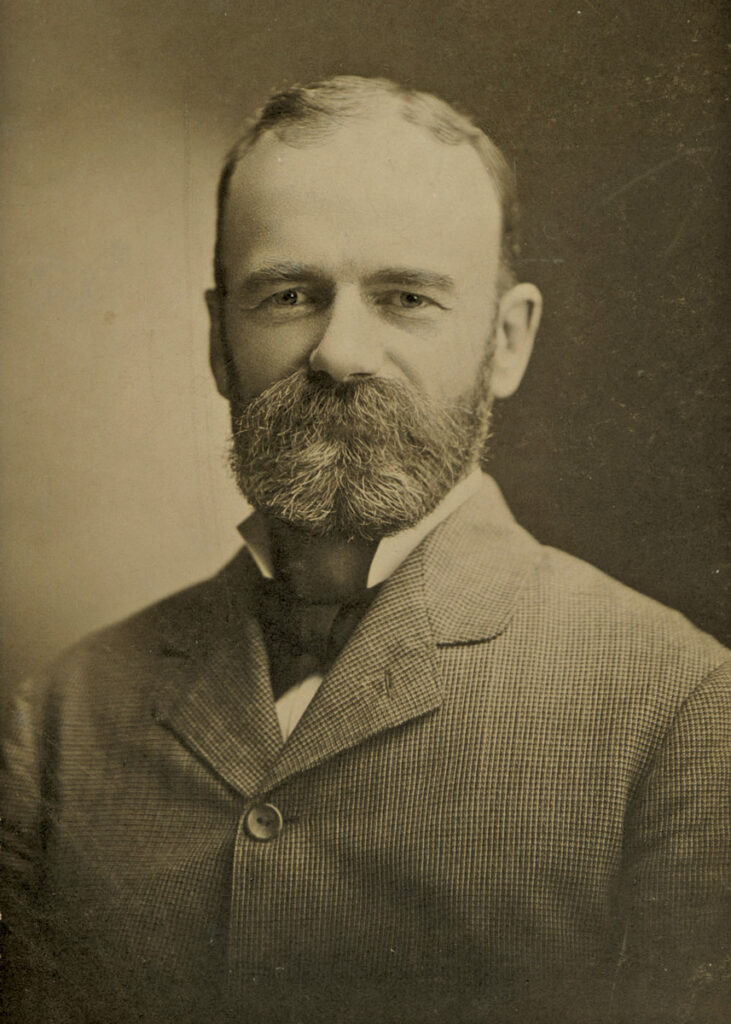
Warren H. Manning, meanwhile, was one of the most highly regarded landscape designers of his era. With a hands-on background in horticulture, his career took off when Frederick Law Olmsted hired him for the Olmsted firm (of Central Park and Prospect Park fame) – where, for example, he led floral designing of the 1893 Chicago World’s Fair. He worked on the grounds of Capitol Hill, Rock Creek Park, and the National Zoo in Washington, D.C.; the Potantico, N.Y., estate of John D. Rockefeller; and Stanford University. In leaving the Olmsteds, Manning went on to design the extensive properties of many turn-of-the-century industrial titans: Tufts, Draper, Vanderbilt, Sieberling, Busch, Houghton,
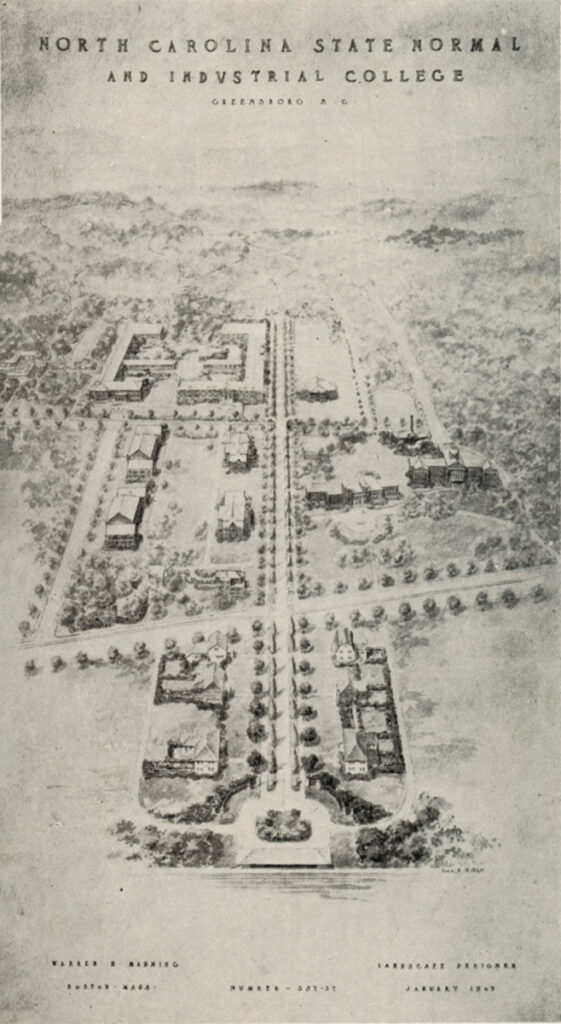
Pabst, McKormick all called on him. In all, he designed more than 1,600 landscapes throughout the United States, including the parks of Minneapolis, Milwaukee, Des Moines, and Miami, Fla. He designed grounds of the New York Zoological Gardens, Cornell University, Princeton University, University of Virginia (expansion), and Tuskegee University. His city planning work for Warren, Ariz.; Birmingham, Ala.; and Athens, Ga., was visionary. In North Carolina, he led the landscape design work on Vanderbilt’s Biltmore Estate and Village. At Tufts’ new Pinehurst Village, he was for several decades the primary designer of seemingly everything except for the buildings and the golf courses. He even advised on the Village Chapel’s construction, according to “Warren H. Manning: Landscape Artist and Environmental Planner (2017).” This detailed reference book has recently restored the luster to the exceptional reputation he had a century ago.
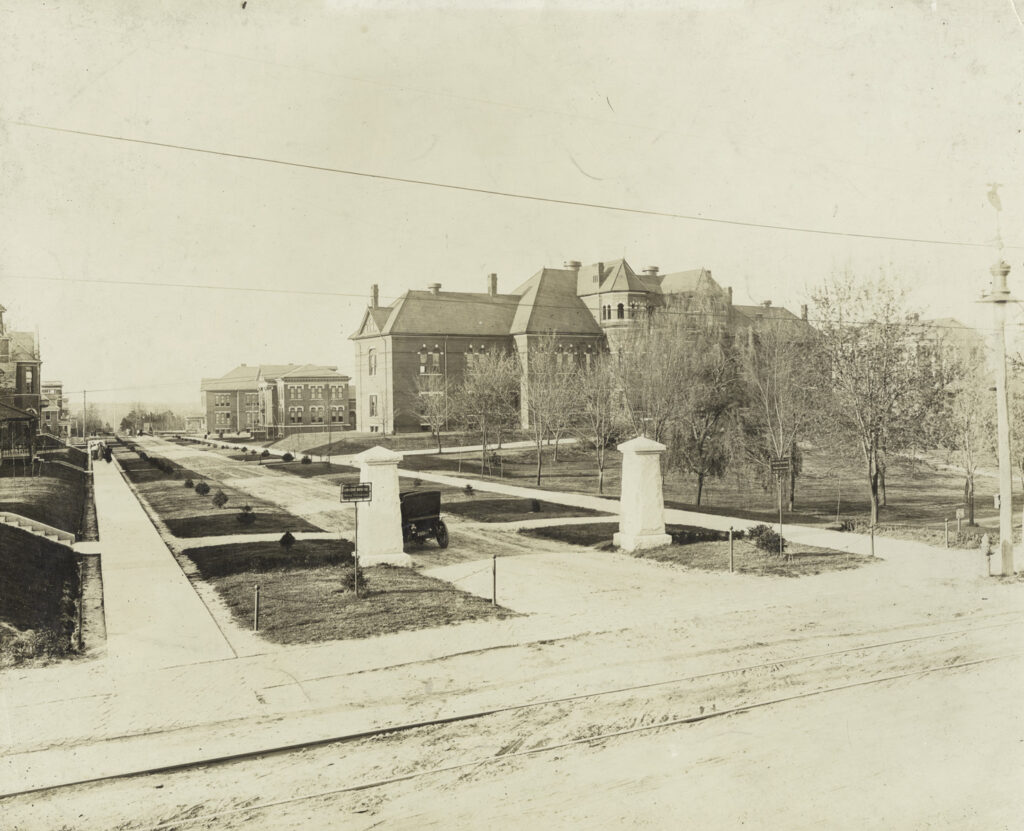
“Maintain the full value of the long vista.”
Manning’s advice to President Foust, March 1908
How did this star come to design the then-small State Normal (now UNCG) campus, which had few finances for such things? As the story has been told, one day a Pinehurst hotels manager searching for an outstanding secretary came into the Commercial Department. Inspecting all the students’ work, he was most impressed with Kittie’s – and offered her a position. She accepted, working there for about two years. Her work and professionalism caught the attention of others, evidently.
Here is how it’s written in “Leaves from the Stenographers’ Note Books”:
“Mr. Manning, like the hotel man, was impressed with the efficiency of the young woman in the office at Pinehurst, and asked her to come up higher. She went to Boston. To show the estimation in which she was held by that firm, she was given within six weeks the “Power of Attorney,” the legal right to sign checks and legal contracts, etc. When she was at Pinehurst living among the beautiful grounds of that resort, she often wished that something might be done to beautify the unsightly red clay hill around the Normal college. But how? That was the question. After going to Boston and living in the heart of landscape garden making, she conceived the idea of asking Mr. Manning to lay out the Normal grounds and let her give the plans to her Alma Mater.”
She had learned that he occasionally did pro bono work for causes he deemed important – such as the Hampton Institute and Tuskegee Institute campuses.
It took a while to work up the courage and find the right time to make her appeal. You can imagine – it would be a huge personal favor. She finally asked. He immediately agreed.
“Mr. Manning came to the College, laid off the grounds and presented us with the plans, in the name of Miss Kittie Dees. The only cost to the college consisted of the actual amount expended for clerical help, drafts, and traveling expenses.”
In that book College Treasurer E.J. Forney adds: “Dr. McIver considered the gift of Miss Kittie Dees, of Grantsboro, the largest gift yet made to the college, not excepting that of Mr. Peabody, who gave $5,000 to develop the plans of Miss Dees.”
Fundraising for the burgeoning college always was top of mind for McIver. In a typed letter to George Foster Peabody, Oct. 1901, McIver writes, “One of our brightest students has been in Mr. Manning’s employ for some time and manages his office in his absence … (He will do work without any charge except the actual expenses.) I write to inquire when you had planned to furnish us the money for this work. We are ready to begin it now as soon as we get our plans.”
Correspondence between Manning and President McIver and later with President Foust, covering nearly two decades, is preserved by UNCG’s University Archives. Their records include Manning’s reports, drawings, and surveys, including a large topographical map plotting seemingly every tree and planting and change in elevation on campus. UNCG Grounds thoughtfully saved this large topographical study of campus, which is now a prized possession of the Archives.
Manning traveled throughout the nation, with many projects ongoing. Some of the correspondence preserved in UNCG Archives plans the timing of his visits. To conserve finances, he visited the campus in combination with travel to other locations such as Pinehurst or towns further south.
A 1913 report in The Carolinian raved about the campus, “How changed it is! … All the gullys are filled. College Avenue is a broad, beautiful street. Down at its further end is the entrance to Peabody Park, where the students can come close to the heart of nature.”
It all started with developing a beautiful, functional College Avenue. His drawings envisioned a pedestrian lane, lined with ornamental trees, all the way to the edge of Peabody Park. The avenue would help show off the campus to all those passing on the train. (The campus’ site had originally been selected for the promotional value of being viewed from the train.) As he stated in a report, “Persons passing by on the trains will secure an impressive view of the Institution taken as a whole.” He
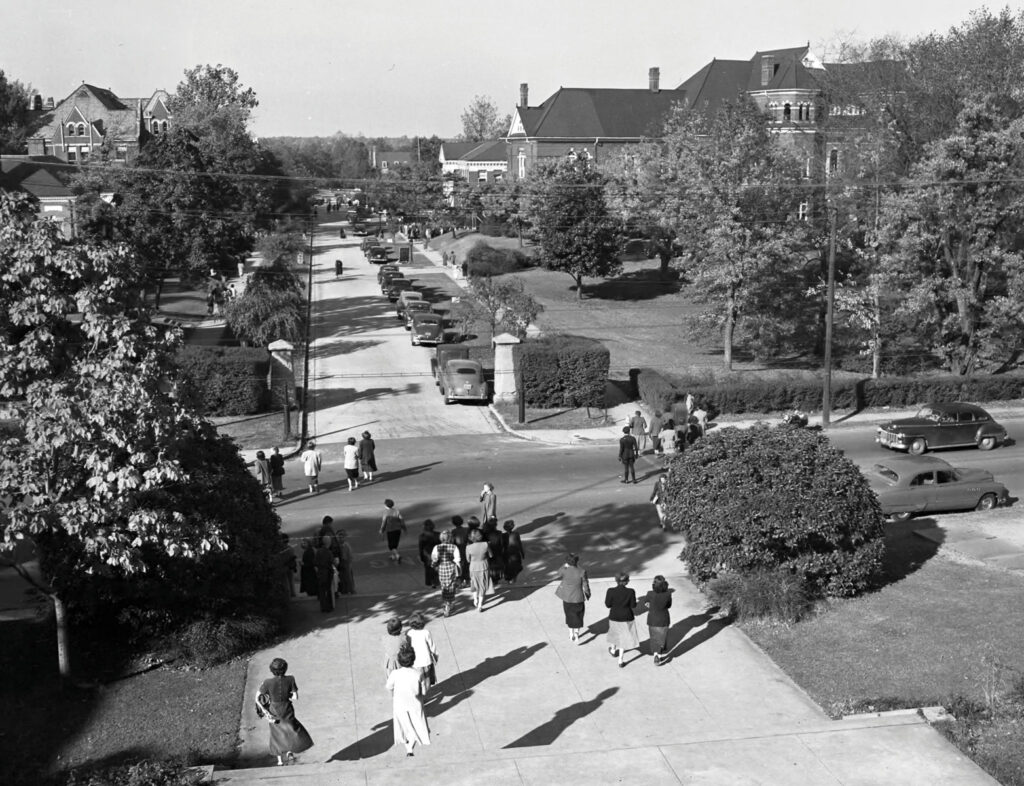
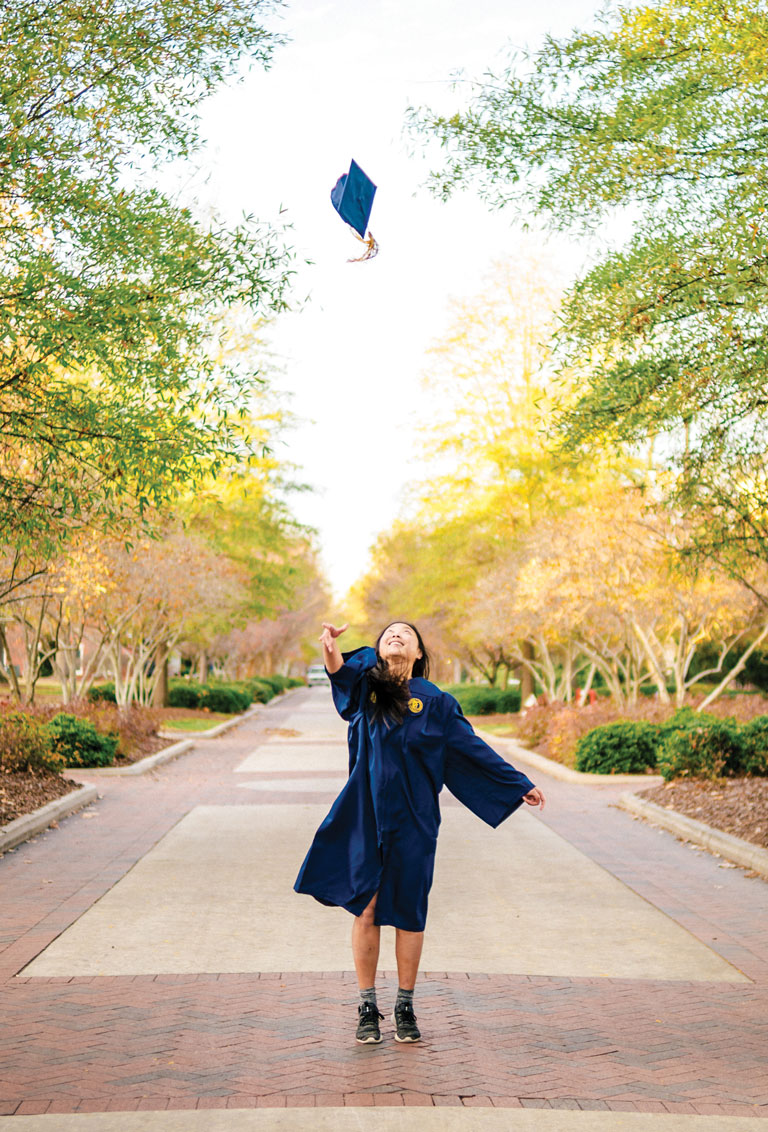
advised that the property between Spring Garden and railroad be purchased, to ensure an unbroken view.
If you’d ever wondered how UNCG developed the most pleasing grounds of any UNC System campus, now you know. The nationally renowned figure continued as official landscape architect of the college through 1921. He advised on the siting of buildings – for example, when the original McIver Building was being planned, he exhorted not to place it on the same line as Main Building (Foust), the only original building still standing, as it would dominate it. When Brick Dormitory burned in 1904 and Spencer was quickly built, McIver asked him via letter, “What do you think of locating our dormitories opposite the (original) Curry Building and facing east on College Avenue?”
He planned the grounds of all we now know as the central part of campus. Tradition credits him with planning Peabody Park, UNCG Archives notes. Records indicate he even designed the grounds of the Quad, whose first residence hall, Shaw, opened in 1919.
College Avenue was always the emphasis. In one of his earliest planning documents for the burgeoning campus, Manning wrote: “The plan of the Institution is governed by the topography. The long boulevard follows the summit of the ridge.” It would be the backbone of campus. He soon determined that it could be narrower and closer to buildings than he’d originally planned. College Avenue was the first campus road Manning wanted to prepare for proper draining. It was paved in 1928. As automobiles
became more than a novelty and then ubiquitous, it was lined with parked cars each day. But, in 2004, it was finally returned to its pedestrian status, and new ornamental and tree plantings were begun in earnest – more planted than ever before.
Over the past decade, it has become an iconic spot for graduation photos. If McIver, Manning, Dees, and Foust could see it now! Just imagine their delight – a culmination of the best-laid plans. As Forney said more than 100 years ago, “We see these plans yet unfolding as the college expands, and the grounds are becoming more beautiful as the years pass.”
By Mike Harris ‘93 MA
Photo 1: “Construction on Lower Approach Road” at Biltmore, March 4, 1891. This shows the Lower Approach Road on Biltmore Estate, Asheville, N.C., under construction. George Vanderbilt is seated on the stone wall in the foreground. Standing to the right of Vanderbilt is Philip Codman and standing to the right of him is Warren H. Manning. Frederick Law Olmsted Sr. is standing behind Vanderbilt. A majority of the men seen are unidentified. (BHA4-01612) Photo detail used with permission from The Biltmore Company, Asheville, North Carolina.
Photo 2: “George Vanderbilt, Frederick Law Olmsted Sr., Philip Codman, Chauncey Beadle, Warren Manning, and work crew standing on Approach Road,” March 4, 1891. Standing to the right in the front row is George Vanderbilt, holding a stick; to the left of Vanderbilt is Frederick Law Olmsted Sr., and Philip Codman is to the left of OImsted. To the right of Vanderbilt two men are seated on the rocks wearing bowler hats. On the left is Chauncey Beadle and to the right is Warren H. Manning. Behind and around them are numerous unidentified workmen. The man on the horse is most likely the landscape department head, James Gall Jr. (BHA4-01815) Photo detail used with permission from The Biltmore Company, Asheville, North Carolina.
Photo 3: Looking north on College Avenue, early 1920s. Students are seen socializing on the well-drained dirt road that’s lined with trees. Courtesy UNCG’s Martha Blakeney Hodges Special Collections and University Archives
Photo 4: Manning brothers, Warren H. Manning seated in center. LF.M3169, Lowell Files Collection, Photograph and Images Files, Center for Lowell History, University Library, University of Massachusetts Lowell. Used with permission.
Photo 5: Warren H. Manning at work on the construction of an octagon office building in North Billerica, Mass., likely spring 1917. Lowell Files Collection, Photograph and Images Files, Box 82 of the Warren H. Manning Collection, Center for Lowell History, University Library, University of Massachusetts Lowell. Used with permission.
Photo 6: Pinehurst village; landscape design by Warren H. Manning. Hand-tinted archived postcard, courtesy of The Tufts Archives, Pinehurst, N.C.
Photograph credits for article above:
Skateboarder on College Avenue and graduate tossing mortarboard. Photos by Sean Norona.
Portrait of Warren H. Manning, courtesy Center for Lowell History, University of Massachusetts Lowell; and Manning Association.
Manning, Warren H., January 1909, Project #537-37 North Carolina State Normal and Industrial College [drawing, birds-eye view], Warren Manning Collection, Center for Lowell History, University Library, University of Massachusetts Lowell.
Three archival campus photographs courtesy UNCG’s Martha Blakeney Hodges Special Collections and University Archives.
Sources/assistance for article:
The writers of “Leaves from the Stenographers Notebooks: Side Lights on Dr. McIver at Work,” Elisabeth Ann Bowles’ “A Good Beginning,” UNCG’s SCUA (particularly archivist emeritus Hermann Trojanowski), archivists at Center for Lowell History – UMass Lowell, Biltmore, and Village of Pinehurst, the Manning Association, the writers/editors of “Warren H. Manning: Landscape Architect and Environmental Planner,” and the UNCG Grounds staff who’ve provided information to the writer over the years and enhanced the campus’ beauty.
